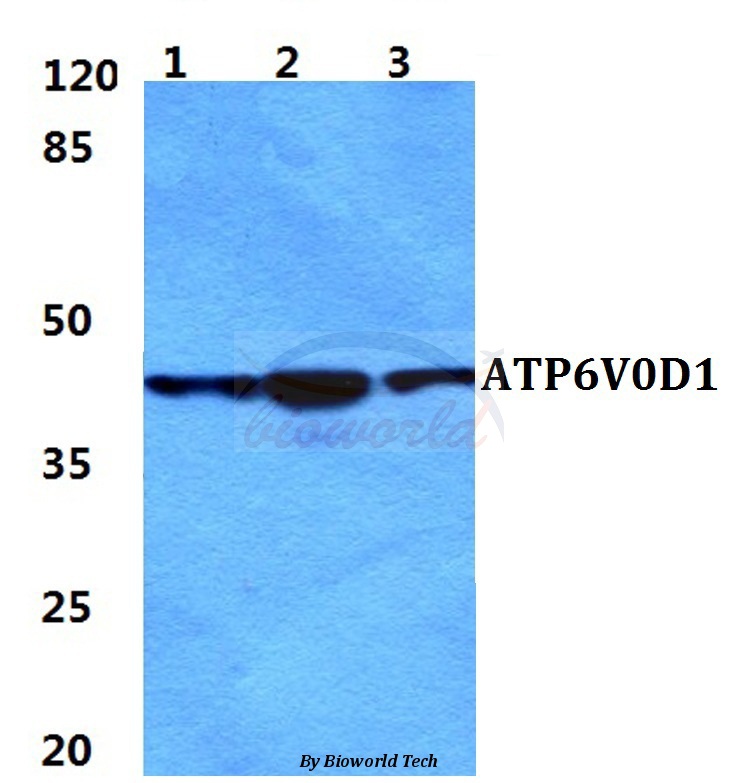Product Name :
ATP6V0D1 polyclonal antibody Background :
Vacuolar-type H+-ATPase (V-ATPase) is a multisubunit enzyme responsible for the acidification of eukaryotic intracellular organelles. V-ATPases pump protons against an electrochemical gradient, while F-ATPases reverse the process, thereby synthesizing ATP. A peripheral V1 domain, which is responsible for ATP hydrolysis, and an integral V0 domain, which is responsible for proton translocation, comprise the V-ATPase complex. Nine subunits (A–H) make up the V1 domain and five subunits (A, D, C, C' and C") make up the V0 domain. V-ATPase D1 (ATPase, H+ transporting, lysosomal, V0 subunit D1), also known as ATP6V0D1, P39, VATX, VMA6, ATP6D or VPATPD, is the D subunit of the V0 domain. Expressed ubiquitously, V-ATPase D1 acts in concert with other V0 subunits to catalytically acidify a variety of intracellular compartments, thereby synthesizing ATP to be used for vacuolar transport. Product :
Rabbit IgG, 1mg/ml in PBS with 0.02% sodium azide, 50% glycerol, pH7.2 Storage&Stability :
Store at 4°C short term. Aliquot and store at -20°C long term. Avoid freeze-thaw cycles. Specificity :
ATP6V0D1 polyclonal antibody detects endogenous levels of ATP6V0D1 protein. Immunogen :
Synthetic peptide, corresponding to amino acids 280-325 of Human ATP6V0D1. Conjugate :
Unconjugated Modification :
Unmodification
ATP6V0D1 polyclonal antibody Background :
Vacuolar-type H+-ATPase (V-ATPase) is a multisubunit enzyme responsible for the acidification of eukaryotic intracellular organelles. V-ATPases pump protons against an electrochemical gradient, while F-ATPases reverse the process, thereby synthesizing ATP. A peripheral V1 domain, which is responsible for ATP hydrolysis, and an integral V0 domain, which is responsible for proton translocation, comprise the V-ATPase complex. Nine subunits (A–H) make up the V1 domain and five subunits (A, D, C, C' and C") make up the V0 domain. V-ATPase D1 (ATPase, H+ transporting, lysosomal, V0 subunit D1), also known as ATP6V0D1, P39, VATX, VMA6, ATP6D or VPATPD, is the D subunit of the V0 domain. Expressed ubiquitously, V-ATPase D1 acts in concert with other V0 subunits to catalytically acidify a variety of intracellular compartments, thereby synthesizing ATP to be used for vacuolar transport. Product :
Rabbit IgG, 1mg/ml in PBS with 0.02% sodium azide, 50% glycerol, pH7.2 Storage&Stability :
Store at 4°C short term. Aliquot and store at -20°C long term. Avoid freeze-thaw cycles. Specificity :
ATP6V0D1 polyclonal antibody detects endogenous levels of ATP6V0D1 protein. Immunogen :
Synthetic peptide, corresponding to amino acids 280-325 of Human ATP6V0D1. Conjugate :
Unconjugated Modification :
Unmodification
-
 Western blot (WB) analysis of ATP6V0D1 polyclonal antibody at 1:500 dilution Lane1:HEK293T cell lysate Lane2:sp2/0 cell lysate Lane3:H9C2 cell lysate
Western blot (WB) analysis of ATP6V0D1 polyclonal antibody at 1:500 dilution Lane1:HEK293T cell lysate Lane2:sp2/0 cell lysate Lane3:H9C2 cell lysate
Bioworld Biotech only provide peptides for our antibodies and do not provide additional peptide customization services.
Price/Size :
USD 368/1mg/vial
Tips:
For phospho antibody, we provide phospho peptide(0.5mg) and non-phospho peptide(0.5mg).Describe :
Blocking peptides are peptides that bind specifically to the target antibody and block antibody binding. These peptide usually contains the epitope recognized by the antibody. Antibodies bound to the blocking peptide no longer bind to the epitope on the target protein. This mechanism is useful when non-specific binding is an issue, for example, in Western blotting (WB) and Immunohistochemistry (IHC). By comparing the staining from the blocked antibody versus the antibody alone, one can see which staining is specific; Specific binding will be absent from the western blot or IHC performed with the neutralized antibody.Formula:
Synthetic peptide was lyophilized with 100% acetonitrile and is supplied as a powder. Reconstitute with 0.1 ml DI water for a final concentration of 10 mg/ml.The purity is >90%,tested by HPLC and MS.
Storage:
The freeze-dried powder is more stable. For short time at 2-8°C. For long term storage store at -20°C.
Note :
This product is for research use only (RUO only). Not for use in diagnostic or therapeutic procedures.
 ATP6V0D1 polyclonal antibody
ATP6V0D1 polyclonal antibody  Datasheet
Datasheet COA
COA MSDS
MSDS SHIP
SHIP